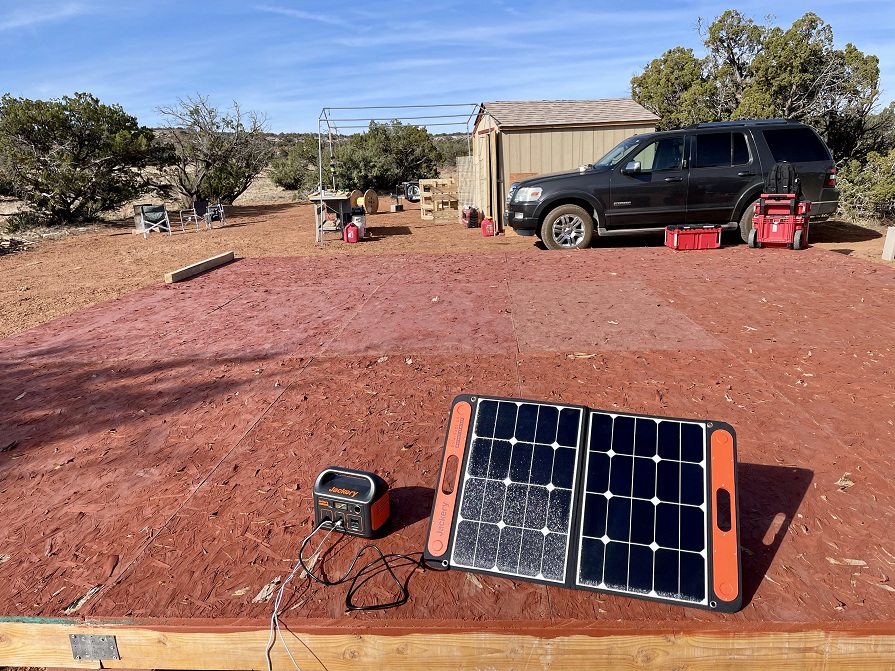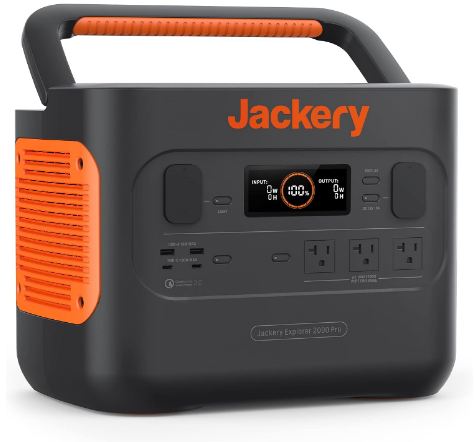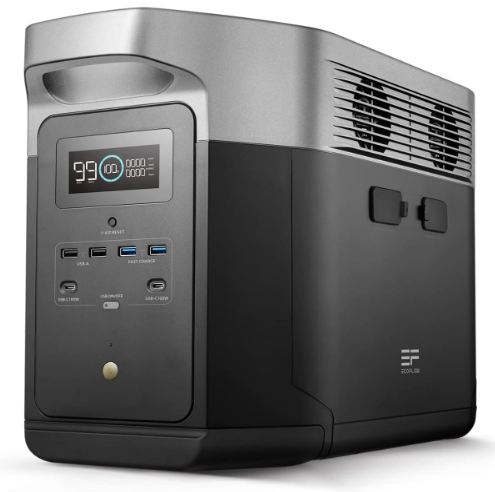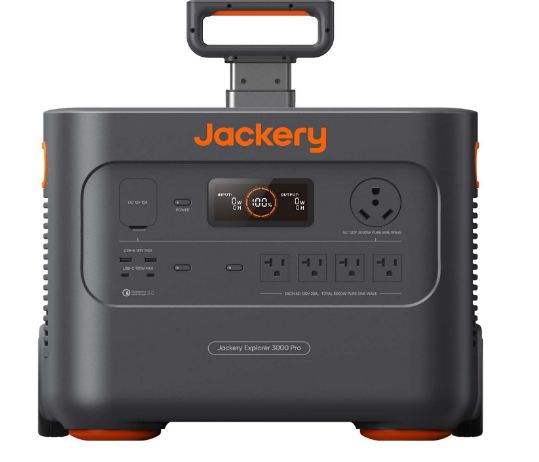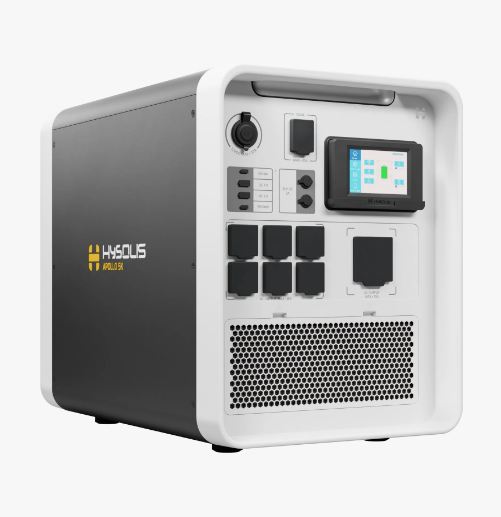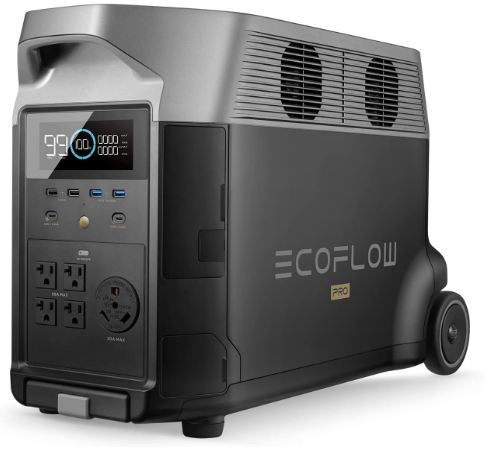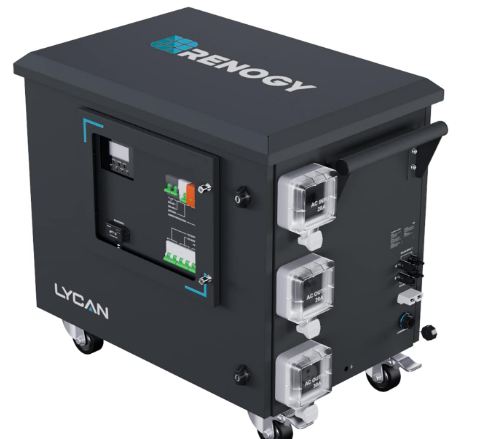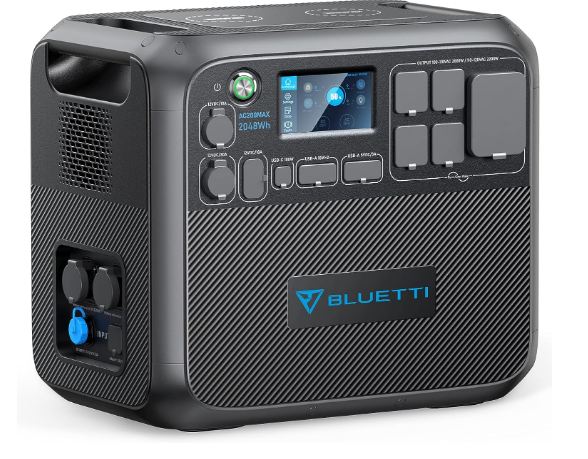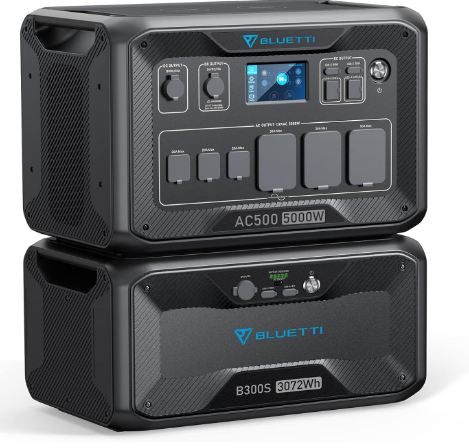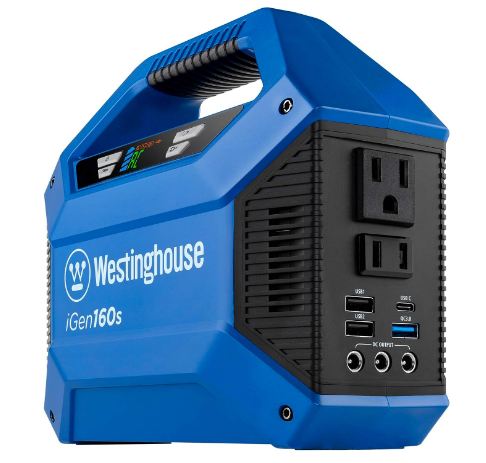Shopping for a solar generator?
You have come to the right place.
Solar generators are the new frontiers of renewable energy. They offer clean, eco-friendly and safe energy at home and away.
Solar generators are also a lot more convenient and user-friendly compared to traditional solar systems. All the components — battery, inverter, charge controller, circuit breakers, outlets & inlets — come pre-wired inside a solid casing.
Instead of spending a lot of money and time wiring up a solar system, a solar generator is plug and play.
While they are not yet as powerful as large standby gas generators, solar generators are quickly catching up. A few years ago, solar generators were mostly good for camping and charging your phone in emergencies. Now, you can find a solar generator that can power your entire home.
In fact, you can find a solar generator that’s perfect for your specific application whether it’s home backup, camping, RV or off-grid living.
What’s In This Guide?
In this guide, we recommend the 10 best solar generators for every application. If you are shopping for a solar generator, this is the best place to start.
We also tell you everything you need to know about choosing the best solar generator for your needs, including what to look for and which brands we trust the most.
This is a fairly long and in-depth buying guide. Use the table of contents to jump to a specific section. We also have a quick summary below of our top picks and how they compare. Use it to quickly find the best solar generator.
If you don't find what you are looking for, see our buying guides on the best solar generators for camping, home backup, and the best portable solar generators.
Best Solar Generators for Every Application
- 1Best Portable Solar Generator: Jackery Explorer 2000 Pro
- 2Best For Truck Camping & Overlanding: EcoFlow Delta Max
- 3Best Solar Generator for Camping: Anker 535
- 4Best Solar Generator for RVs and Boats: Jackery Explorer 3000 Pro
- 5Best Home Standby Solar Generator: Hysolis Apollo 5K
- 6Best Portable Home Backup Solar Generator: EcoFlow Delta Pro
- 7Best Off-grid Solar Generator: Renogy Lycan 5000 Power Box
- 8Best Solar Generator for Most Appliances: Bluetti AC200MAX
- 9Best Solar Generator for Power-hungry Appliances: Bluetti AC500 + B300S
- 10Best Small/Lightweight Solar Generator: Westinghouse iGen160s 155Wh
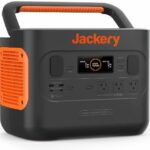
Jackery 2000 Pro
- Best portable
- 2160Wh Li-ion battery
- 2200W output
- Recharges in 2hrs
- Weighs 43lbs
- 5yr warranty
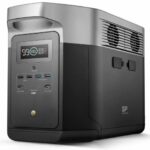
EcoFlow Delta Max
- Best for truck camping & overlanding
- 2016Wh Li-ion battery
- 2400W output
- Recharges in 2.5hrs
- Weighs 48lbs
- 2yr warranty
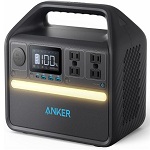
Anker 535
- Best for camping
- 512Wh LiFePO4 battery
- 500W output
- Recharges in 2.5hrs
- Weighs 16.7lbs
- 5yr warranty
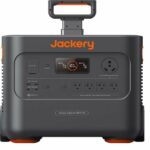
Jackery 3000 Pro
- Best for RVs & boats
- 3024Wh Li-ion battery
- 3000W output
- Recharges in 2.4hrs
- Weighs 63.9lbs
- 5yr warranty
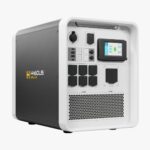
Hysolis Apollo 5K
- Best standby
- 5376Wh LiFePO4 battery
- 3000W output
- Recharges in 1.8hrs
- Weighs 132lbs
- 2yr warranty
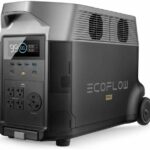
EcoFlow Delta Pro
- Best portable for home backup
- 3600Wh LiFePO4 battery
- 3600W output
- Recharges in 2.7hrs
- Weighs 99lbs
- 2yr warranty
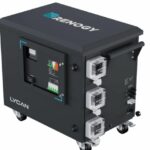
Renogy Lycan 5000
- Best for off-grid
- 4800Wh LiFePO4 battery
- 3500W output
- Recharges in 3hrs
- Weighs 264.6lbs
- 3yr warranty
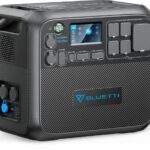
Bluetti AC200MAX
- Best for appliances
- 2048Wh LiFePO4 battery
- 2200W output
- Recharges in 4.5hrs
- Weighs 62lbs
- 2yr warranty
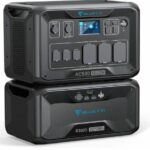
Bluetti AC500 + B300S
- Best for heavy duty appliances
- 3072Wh LiFePO4 battery
- 5000W output
- Recharges in 2.2hrs
- Weighs 66.2lbs + 83.8lbs
- 4yr warranty
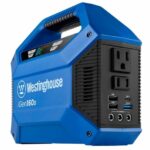
Westinghouse iGen160s
- Best small/lightweight
- 155Wh Li-ion battery
- 100W output
- Recharges in 6hrs
- Weighs 3.7lbs
- 2yr warranty
1. Best Portable Solar Generator: Jackery Explorer 2000 Pro
There are plenty of great portable solar generators in the market. Honestly, it’s hard to pick the best one out of the bunch.
We think the Jackery Explorer 2000 Pro is overall the best solar generator. It’s relatively lightweight yet highly capable. It’s versatile, charges quickly and pricing isn’t too bad.
Pros
Cons
Our Review
Jackery has always been one of the leading makers of portable solar generators. The Jackery 2000 Pro is an upgrade of their popular Jackery 2000.
The new 2000 Pro comes with slightly higher capacity and much better charging speeds. If you are looking for a solar generator you can use on the road or outdoors as well as at home for backup, the Jackery 2000 Pro is a great choice.
2160Wh Capacity With Fast Recharge
The 2160Wh capacity is plenty enough to keep electronics and appliances running for hours or days. Here’s how long the battery can power various items.
Appliance/device | Run time/recharges |
|---|---|
CPAP (40W) | 45.9hrs |
Kitchen refrigerator (350W) | 5.2hrs |
3 Smartphones (30Wh) | 20 recharges each |
Laptop (60Wh) | 30 recharges |
Coffee maker (1350W) | 1.3hrs |
TV (120W) | 15.3hrs |
Electric blanket (145W) | 12.6hrs |
Despite the large capacity, the Jackery 2000 Pro charges really fast. The included AC adapter recharges it in just two hours.
Max solar input is 1400W max, a big improvement from the 800W max input of the original Jackery 2000. This lets you charge the 2000 Pro faster using solar. Six 200W solar panels (1200W) will recharge it in a quick 2.5 hours.
You can also charge the 2000 Pro from your vehicle’s 12V outlet, but that takes 24 hours. It’s only suitable for topping up the solar generator when on the go.
One recharging feature missing is dual charging with AC + solar. This is common in other solar generators and helps reduce charging time.
But we don't think most people will miss dual charging. The 2000 Pro already charges pretty fast with solar or AC.
2200W Output
If you want a portable solar generator that can power most appliances, the Jackery Explorer 2000 Pro is a good pick.
It comes with a built-in 2200W inverter, meaning it can power most household appliances including a full size refrigerator, TV, blender and others.
You can also run power tools off the 2000 Pro.
Plenty of Ways To Charge/Power Electronics
The Jackery 2000 Pro comes with three AC outlets, so you can power multiple appliances at the same time.
There’s also a 12V/10A car port with which you can run your 12V electronics like a car fridge or air compressor.
And for gadgets, the USB situation on the Jackery 2000 Pro is pretty good. There are a couple of 100W USB-C ports and two fast charging 18W USB-A ports. You can plug in a wide range of devices from your smartphone to a USB-C laptop.
About the Weight
The Jackery 2000 Pro weighs 43lbs. That’s not feather light, but it’s not as bulky as some other solar generators either. In comparison, the Bluetti AC200MAX with roughly similar specs weighs 62lbs.
Most people will be able to lift and carry the 2000 Pro over short distances. We recommend the 2000 Pro for car/truck camping, RVs, boats, camper vans and home backup.
If you are shopping for an ultra lightweight solar generator you can easily carry by hand over long distances, see our final pick in this guide (the Westinghouse iGen160s).
Issues & Limitations
The main limitation of the Jackery Explorer 2000 Pro is also what makes it a great portable solar generator — the battery.
The Li-ion battery lasts 1000 cycles to 80% capacity. In contrast, LiFePO4 batteries used in other solar generators like the Bluetti AC200MAX can last up to 3500 cycles to 80% capacity.
On the upside, Li-ion batteries are lighter, which is why the Jackery 2000 Pro weighs a lot less.
2. Best For Truck Camping & Overlanding: EcoFlow Delta Max
Most people who go truck camping or overlanding tend to carry more and bigger electronics and appliances. You probably have a bigger fridge for all your food, an electric cooker, and maybe even a TV.
So you need a solar generator that’s quite capable. It also needs to have fast solar charging to ensure you have a reliably power supply when off-grid. The EcoFlow Delta Max fits the bill.
Cons
Our Review
The EcoFlow Delta Max doesn't take up much space in your rig and it’s fairly easy to move around, but it is highly capable.
If you want reliable power supply for your gadgets, electronics and appliances when truck camping or going on an overlanding trip, we highly recommend the Delta Max. It’s also great for camper vans.
2016Wh Expandable Battery With 2.5hr Solar Recharge
The 2kWh battery capacity is pretty good for a portable solar generator. You should be able to power electronics and smaller appliances for several hours or a couple of days.
Here’s how long the battery lasts (approximately) when powering different electronics.
Appliance/device | Run time/recharges |
|---|---|
CPAP (40W) | 34hrs |
Kitchen refrigerator (350W) | 14hrs |
Car fridge | 33hrs |
Smartphone | 175 recharges |
Laptop | 32 recharges |
Coffee maker | 1.9hrs |
50” TV | 15hrs |
One of the reasons we think the Delta Max is perfect for overlanders and campervans is that you can expand the capacity. EcoFlow sells expansion batteries that increase capacity to 6kWh.
The extra capacity is handy if you don't plan to carry solar panels with you or if you are traveling where it won’t be sunny.
If you decide to get solar panels, you can put in up to 800W of solar power to charge the Delta Max in 2.5 hours. This ensures you have a fully charged battery by evening.
If you have access to mains power, the Delta Max recharges via AC in just 1.8 hours.
When on the move, you can plug in the Delta Max into your vehicle’s 12V port to keep it topped up.
Up to 3400W Power Output
The Delta Max has a standard AC output of 2400W. That’s already plenty enough to power multiple appliances at the same time.
If you need more power than that, turn on X-Boost to power up to 3400W appliances. Just keep in mind that the more power you draw from the battery, the faster it will drain.
15 Outlets
The Delta Max has almost double the outlets on the Jackery 2000 Pro. You can plug in up to 15 devices and appliances simultaneously.
You get a whooping 6 AC outlets, so you can run all your appliances at the same time. DC outlets are also in plenty: one 12V car port and two 5.5mm DC outlets.
There are six USB ports, including four USB-A ports and two 100W USB-C ports. So if you are traveling as a group, everyone can charge their devices at the same time.
Issues & Limitations
The Delta Max solar generator has the same limitation as the Jackery 2000 Pro — the Li-ion battery.
It doesn't last as long as a LiFePO4 battery, especially if you use it often. But since you are likely to go camping or overlanding occasionally, you can get well over 5 years from the Delta Max battery.
3. Best Solar Generator for Camping: Anker 535 Portable Power Station
It was a real struggle to pick the best camping solar generator. For a long time, the Jackery Explorer 500 has been our go-to top recommendation for campers. It’s lightweight and has enough capacity & power for whatever electronics casual campers carry with them.
But we feel the Jackery 500 is getting dated and there are better options out there like the Anker 535.
Pros
Cons
Our Review
The Anker 535 is quite similar to the Jackery 500. They are both compact and lightweight and have a similar capacity as well as output.
But there’s one big difference: the Anker 535 uses a LiFePO4 (lithium iron phosphate) battery instead of the Li-ion battery in the Jackery 500. It does make the Anker 535 3 pounds heavier, but on the upside, LiFePO4 batteries last much longer.
The Jackery 500 is good for 800 cycles before battery capacity deteriorates to 80% of original capacity. In contrast, the Anker 535 lasts 3000 cycles.
So you can go camping as often as you want and even use the Anker 535 daily at home and it’ll still last for years and years while still holding plenty of capacity.
Adequate Capacity & Output for Casual Campers
If you are a serious camper who camps for days or goes truck camping with lots of gadgets and appliances, the Anker 535 is not for you.
It’s aimed more at casual campers who plan 1-3 day trips and carry just a few small electronics.
The Anker 535 has a capacity of 512Wh. Here’s how long the battery lasts while powering/charging various items.
Appliance/device | Run time/recharges |
|---|---|
Phone | 40 recharges |
Camera | 30 recharges |
Drone | 10 recharges |
Fan | 11.8hrs |
Mini fridge | 10.4hrs |
The Anker 535 puts out a max of 500W of pure sine wave AC power, with a surge capacity of 750W. That’s enough to power most of the stuff many campers carry with them including gadgets, lights, a car fridge, fan, electric blanket, CPAP machine and other small appliances.
Versatile Outlets
Another reason we feel the Anker 535 is better than the Jackery 500 for camping is that Anker offers better output options.
When it comes to AC output, the Anker 535 spots four household-style 120V outlets compared to Jackery’s one. So you can plug in multiple appliances at the same time. You can keep your car fridge on, while still running the fan and a couple other electronics.
The Anker 535 also has a USB-C 60W port, which the Jackery lacks. So you can power a large device like a laptop or portable projector. You also get three USB-A ports.
There’s also a 12V car port. The only outlets lacking are 5.5mm DC outlets, which are great for powering small 12V electronics like lights. But the cigarette lighter port is adequate for most campers.
Fast Recharging
Forgot to charge the Anker 535 in time? Don’t fret, it only needs 2.5 hrs to recharge. So you can plug it in while you pack your camping gear and it’ll be ready to go when you are done.
To get the 2.5hr recharge time, use the included adapter as well as a USB-C cable at the same time (the USB-C port is an in/out port).
If you plan to camp for longer, you can recharge the Anker 535 with a 120W solar panel. It takes 5-6 hours to recharge in the sun. If the weather conditions are good, you can charge the Anker 535 enough to carry you through the night.
Of course, you can also charge the Anker 535 from your car’s 12V outlet while you are on the road.
Designed for The Outdoors
The Anker 535 weighs 16.7lbs, light enough to carry by hand over short distances. So even if the campsite is not accessible by vehicle, you can still carry the solar generator with you using the built-in handle.
The Anker 535 has a drop-proof unibody design that can withstand rough environments. Just remember that the Anker 535 is not waterproof, or even water resistant. Keep it away from the elements.
By the way, the Anker 535 comes with a generous 5 year warranty, so you know it’s made to last.
Issues & Limitations
As we said, the Anker 535 is probably not suitable for serious campers who go on multi-day camping trips, overlanding or truck camping with all sorts of appliances.
If you need more capacity and power than the Anker 535 has to offer, consider the EcoFlow Delta Max or the Jackery 2000 Pro.
4. Best Solar Generator for RVs and Boats: Jackery Explorer 3000 Pro
The EcoFlow Delta Max or the Jackery 2000 Pro may be fine for camper vans and truck campers, but you probably need something more capable if you have an RV or boat.
You have more appliances to power and they are probably bigger as well. We recommend the Jackery Explorer 3000 Pro.
It’s the newest solar generator from Jackery and offers plenty of power for RVs, motorhomes and boats.
Pros
Cons
Our Review
The Jackery 3000 Pro is one of the most powerful solar generators you can buy that’s actually portable. Similar size or slightly bigger solar generators tend to be a lot heavier.
Take the 3600W/3600Wh Delta Pro for instance (our no. 5 pick below). It weighs 99lbs. In contrast, the 3024Wh/3000W Jackery 3000 Pro weighs about 64lbs.
This is why we think the Jackery 3000 Pro is a great choice for RVs, boats, and any situation where you need a lot of power and capacity on the go.
Huge Battery That Charges Quickly
Jackery’s new portable solar generator comes with a massive 3024Wh Li-ion battery. It lets you power larger and more appliances without draining the battery too quickly.
Here’s approximately how long the 3000 Pro will last running various items.
Appliance/device | Run time/recharges |
|---|---|
CPAP (40W) | 60hrs |
Kitchen refrigerator (350W) | 7hrs |
3 Smartphones (30Wh) | 27 recharges each |
Laptop (60Wh) | 40 recharges |
Coffee maker (1350W) | 1.7hrs |
TV (120W) | 20hrs |
Electric blanket (145W) | 16hrs |
One advantage of the 3000 Pro’s high capacity is that you can comfortably go off-grid for longer. Whether you are boondocking or going on a long cross country road trip, the Jackery 3000 Pro can provide a reliable power supply.
With the large battery, you might be worried about recharging the Jackery 3000 Pro. Worry not, you don't need days to get a full battery.
The 3000 Pro accepts up to 1400W of solar power. Seven 200W SolarSaga solar panels will recharge it in about 3 hours assuming there’s plenty of sunshine.
If you don't have the budget for all those solar panels, four 200W panels recharge it in 5-6 hours.
When you are at home or at an RV park or dock, you can charge the Jackery 3000 Pro from an AC outlet in 2.4 hours.
To keep the solar generator topped up, plug it into your 12V vehicle outlet when you are on the move.
3000W Power Output
With the 3000W inverter in the Jackery 3000 Pro, you can power just about any appliance in your RV or boat.
The 3000 Pro even has a high-power 25A AC output that lets you hook it up directly to your RV (though you may need a 30A or 50A to 25A adapter depending only your shore power cable). This lets you easily power several appliances at the same time without plugging them into the solar generator.
No Shortage of Outlets
In addition to the 25A outlet, you also get four standard 20A AC outlets.
As for DC power, Jackery offers a single 12V/10A car port. They still don’t offer 5.5mm DC outlets, which have become standard on most solar generators.
As for USB ports, you get two USB-A outlets (the 18W fast charging kind) and two 100W USB-C ports, meaning you can power your laptop.
Overall though, other brands like EcoFlow and Bluetti are better when it comes to outputs. They offer more options and a wider variety such as 30A RV port, wireless charging pads and 5.5mm DC ports.
Heavy but Portable
At 63.9lbs, the Jackery 3000 Pro is not lightweight. But it could be worse. Other 3kW solar generators tend to be much heavier.
To make it easier to move the solar generator around, Jackery has added wheels and a retractable handle to the 3000 Pro. So you should be able to maneuver it around your RV, home or campsite.
Issues & Limitations
If you are shopping for a solar generator with expandable capacity, the Jackery 3000 Pro is not it. You need to be sure that the 3kWh capacity will be adequate for your needs.
If you want an expandable solar generator for your RV or boat, check out the Bluetti AC200MAX or EcoFlow Delta Pro.
5. Best Home Standby Solar Generator: Hysolis Apollo 5K
It used to be almost impossible to find a solar generator powerful enough to replace a traditional standby gas generator.
But solar generators have been getting increasingly powerful. With a possible output of up to 27kW, the Hysolis Apollo 5K qualifies as a proper home standby solar generator.
Pros
Cons
Our Review
There are few solar generators as impressive as the Apollo 5K. While plenty of solar generators offer expandability, none are as scalable as the Apollo 5K.
You can expand both capacity and output to a point where the Apollo 5K could power your entire home. Then using a transfer switch, you can easily switch between utility and backup power.
Massive Capacity and Insane Recharging Performance
The Apollo 5K comes with a 5,376Wh LiFePO4 battery, making it one of the largest solar generators in the market.
You can expand this to 48.4kWh by adding eight more expansion batteries, plenty enough to power your home for a couple days or more.
If you are wondering how long the 5.3kWh battery will last, here’s a rough estimate.
Appliance/device | Run time/recharges |
|---|---|
Microwave (900W) | 5hrs |
Kitchen refrigerator (350W) | 13hrs |
3 Smartphones (30Wh) | 50 recharges each |
Laptop (60Wh) | 76 recharges |
Coffee maker (1350W) | 3.3hrs |
TV (120W) | 38hrs |
Window AC (1500W) | 3hrs |
To match the large capacity, the Hysolis Apollo 5K has one of the best recharging speeds in the market.
Max solar input is an insane 4000W, which can recharge the Apollo 5K in just 90 minutes. AC charging is just as fast with a 110 minute recharge time.
For even faster charging, you can combine AC and solar to get max 6kW input and charge the Apollo 5K in 55 minutes. It’s wild that you can charge a 5+ kWh battery in under an hour at home.
Highly Scalable Output
The Apollo 5K is the first solar generator we’ve seen that lets you expand both capacity and power output.
You can link up to nine Apollo 5K units to increase power output from 3kW to 27kW. That’s enough to power your entire home and easily matches the capability of large gas standby gas generators.
Of course, you don't need to expand to 27kW all at once. You can start with a couple of Apollo 5K units to get 6kW output and 10.7kWh capacity.
Versatile Outlets
The easiest way to use the Apollo 5K for home backup is to connect it directly to your home circuit via a transfer switch. The solar generator has a 120V/25A output for exactly that.
There are also six regular 15A 120V outlets for when you want to plug appliances directly into the solar generator.
A 12V/30A DC outlet is handy for powering an RV or boat while the 12V/15A car port and two 5.5mm DC outlets let you power DC electronics.
And for USB you get three USB-A ports and a 60W USB-C PD port. There’s also a 5V wireless charging pad.
Issues & Limitations
The Apollo 5K is obviously not a good choice if you are shopping for a portable solar generator. It weighs 132lbs. It’s a standby, not a portable solar generator.
That said, there are a couple of options if you need to maneuver it around your home. The battery is removable, which halves the weight for easier movement,
You can also order a wheeled cart from Hysolis for moving the Apollo 5K around.
The other issue with the Hysolis Apollo 5K is the price tag. It’s not cheap, and that’s before you start expanding it.
If you are looking for a more pocket-friendly or portable home backup solar generator, check out our next pick below.
6. Best Portable Home Backup Solar Generator: EcoFlow Delta Pro
If you are in need of a home backup solar generator but find the Hysolis Apollo 5K to be too big or expensive, we recommend the EcoFlow Delta Pro.
It is still fairly pricey, but it’s about a thousand bucks cheaper than the Apollo 5K. It is also 33lbs lighter than the Apollo 5K.
Pros
Cons
Our Review
While not quite as capable or scalable as the Apollo 5K, the EcoFlow Delta Pro is a beast in its own right. It’s one of the most powerful portable solar generators in the market right now, which is why we think it’s a great choice for home backup.
3600Wh Expandable Battery
3.6kWh is plenty of capacity to back up essential appliances for several hours or even days depending on what you plug in.
And if that’s not enough, you can order extra batteries to expand capacity to 25kWh.
Here’s the approximate runtime you’ll get from the Delta Pro. You can double or triple these times by adding expansion batteries.
Appliance/device | Run time/recharges |
|---|---|
CPAP (40W) | 50hrs |
Fridge (120W) | 24hrs |
Microwave (1300W) | 2.5hrs |
Smartphone (11Wh) | 313 recharges |
Laptop (60Wh) | 57 recharges |
Coffee maker (1000W) | 3.3hrs |
50” TV (110W) | 27hrs |
As with any EcoFlow solar generator, charging performance is not an afterthought. The Delta Pro has some impressive charging speeds.
Plug it into a standard wall outlet and it recharges in 2.7 hours. In an emergency, you can put in up to 1600W of solar power to charge the Delta Pro in 3-4 hours.
You can also charge it from your vehicle, a level 2 EV charger, or the EcoFlow smart generator. The Delta Pro also allows multiple charging methods at the same time for even faster charging.
So not only does the Delta Pro charge fast, it offers plenty of charging options to ensure you are covered no matter the emergency.
3600W to 7200W Massive Output + Optional Home Integration
The Delta Pro will power just about any appliance in your home during an emergency. In fact, it can power multiple appliances thanks to the 3600W output.
An easy way to do this is getting the EcoFlow home integration kit, which lets you power appliances right where they are.
If 3600W is not enough, the Delta Pro has a trick that lets you power appliances up to 4500W. It’s called X-Boost.
There’s also an option to draw 240V, 7200W power from the Delta Pro for large 208-240V appliances like the dryer, AC or well pump. But you’ll need a second Delta Pro for that.
All The Outlets You Need
The Delta Pro comes with…you know what, it’s easier to just list all 15 of them.
- Five AC outlets - 3600W total
- One 30A Anderson port
- Two USB-A ports - 5V, 2.4A
- Two QC USB-A ports - 18W each
- Two USB-C ports - 100W each
- Two DC5521 outlets - 38W each
- One car outlet - 12V, 126W
The only option we’d have loved to see is a wireless charging pad.
Issues & Limitations
We said the Delta Pro is both cheaper and lighter than the huge Hysolis Apollo 5K. But keep in mind that the Delta Pro is also pricier and heavier than many of the portable solar generators in the market.
If you are looking for a low or mid budget solar generator (under $2,000) or you prefer a lightweight unit, consider another alternative like the Bluetti AC200MAX or the Jackery 2000 Pro. They can both provide plenty of backup power.
7. Best Off-grid Solar Generator: Renogy Lycan 5000 Power Box
If you are shopping for a solar generator that can power your off-grid cabin, tiny home, outdoor shed, or any other off-grid situation, our top recommendation is the Renogy Lycan 5000 Power Box.
Pros
Cons
Our Review
The Renogy Lycan’s rugged design is one of the main reasons we think it is great for off-grid solar power. It can withstand harsh environments, making it perfect for an off-grid cabin, an outdoor shed or a tiny home in the mountains.
Thanks to the weatherproof housing, Renogy says you can install it either indoors or outdoors. Obviously, you should still shelter it if you plan to keep it outdoors.
4800Wh Expandable Battery
Another reason the Lycan 5000 is excellent for off-grid use is the huge capacity you have at your disposal. The solar generator comes with two 48V, 50Ah batteries for a combined capacity of 4.8kWh.
That’s enough to power a cabin or small home for a few hours to a few days. Here’s how long the Lycan 5000 can power various items.
Appliance/device | Run time/recharges |
|---|---|
Refrigerator (135W) | 60 hours |
TV (120W) | 34 hours |
Washing machine (500W) | 8 cycles |
Coffee maker (900W) | 90 cups |
Heater (1500W) | 2.7 hours |
Power tool (1000W) | 4 hours |
If you need more capacity, you can add up to six additional 48V Renogy LiFePO4 batteries for a total possible capacity of 19.2kWh.
3500W Output
The Lycan 5000 comes with a 3500W (7000W surge) pure sine wave inverter that can power pretty much any appliance, including large ones like an air conditioner, oven and power tools.
Unfortunately, there isn’t a split phase output option, so you cannot power any 240V appliances unless you use an adapter.
Easy Home Integration
Unlike most solar generators, the Lycan 5000 doesn't have many output options. It has just two: a 20A and a 30A 120V outlet.
You can plug appliances directly into these outlets or use a heavy duty power strip. But the Lycan 5000 is primarily designed for home integration. It’s most convenient when you connect it to a circuit via a breaker panel.
That way, you can easily power multiple appliances and devices from different outlets in your home.
Fast Charging
With high-capacity and expandable solar generators like the Lycan 5000, you always want fast charging performance to ensure the huge batteries don't become a liability.
The Lycan 5000 passes with flying colors. It has two charging options: solar & AC.
Plug it into a standard wall outlet and it recharges in 3 hours. You can also connect up to 4400W of solar power to charge it in about the same time, assuming it’s sunny.
For even faster charging, use solar and AC charging at the same time to charge it in just 1.3 hours.
Issues & Limitations
Like other extra-large solar generators, the Lycan 5000 is expensive. If you think you can make do with less output and capacity, consider a cheaper alternative like the Delta Max or the Bluetti AC200MAX.
It’s also really heavy and bulky, which makes moving it around difficult. We recommend setting it up in one place and leaving it there.
8. Best Solar Generator for Most Appliances: Bluetti AC200MAX
If you want a solar generator that can power appliances whether it’s at home, in your RV, offgrid or anywhere else, our top pick is the Bluetti AC200MAX.
It can power just about any appliance, has plenty of outlets to run multiple appliances and features expandable capacity so you can fit it to your needs.
Pros
Cons
Our Review
The AC200MAX’s 2200W output means it can power most household appliances including large ones like a kitchen refrigerator, portable AC, space heater and others.
It’s a great choice if you are shopping for a capable, but pocket-friendly, solar generator that can run appliances for several hours or days. It’s great for home backup, and also portable enough to use in your RV, campervan or truck.
Expandable Capacity
The Bluetti AC200MAX comes equipped with a 2048Wh LiFePO4 battery. If you need extra capacity, Bluetti sells expansion battery packs that let you increase capacity to 8192Wh.
This is handy if you want a longer lasting home backup system or if you want to power bigger appliances that draw a lot of power such as a 1500W heater or a 2000W grill.
Here’s an estimate of how long the Bluetti AC200MAX will power various appliances and devices.
Appliance/device | Run time/recharges |
|---|---|
Mini fridge (60W) | 28.3hrs |
Full size refrigerator (150W) | 11.3hrs |
TV (100W) | 17hrs |
Smartphone (10Wh) | 170 recharges |
Laptop (60Wh) | 28 recharges |
CPAP (40W) | 42.5hrs |
No Shortage of Outlets
Thanks to the four AC outlets, you can easily run four appliances at the same time using the Bluetti AC200MAX. Just make sure you do not exceed a total draw of 2200W.
If you are planning to use the AC200MAX in your RV, trailer or campervan, there are a couple of outlets that you’ll find useful: a 120V 30A NEMA TT-30 outlet and a 12V/30A DC outlet. So you can supply your RV with 30 amp AC or DC power directly from the AC200MAX.
Other output options include USB-A ports, 100W USB-C port, a 12V car port and two 15W wireless charging pads.
Fast Charging
You can recharge the Bluetti AC200MAX in 7 different ways, and most of them are pretty fast.
A wall outlet will recharge it in 4.5 hours. Get a second adapter and use two wall outlets to cut charging time to 2.5 hours.
Solar (max 900W) takes 2.7 hours if it is sunny. You can combine solar and a wall outlet to bring that down to a quick 2 hours.
You can also recharge the AC200MAX from a gas generator (same charging time as a wall outlet), a lead-acid battery and your vehicle’s 12V/24V socket.
Issues & Limitations
While the Bluetti AC200MAX is portable, it is not the easiest solar generator to carry around. It weighs 62lbs, making it heavier than some similar size solar generators (LiFePO4 batteries are heavier than Li-ion batteries).
If you are shopping for something lighter but just as powerful, get the Jackery 2000 Pro (43lbs).
Another limitation of the Bluetti AC200MAX is that it is limited to regular household appliances. It’s not powerful enough for heavy duty appliances like a home water heater, a high-powered electric range or a central AC system.
For such power-hungry appliances, see our next recommendation below.
9. Best Solar Generator for Power-hungry Appliances: Bluetti AC500 + B300S
1800W induction cooker? Easy. 3000W AC system? No sweat. 5000W 240V garage heater? Bring it on.
The Bluetti AC500, along with the included B300S battery pack, is a beast. With an output of 5000W, it is one of the most powerful solar generators in the market. It’s a great choice if you need a highly capable solar generator to run heavy duty appliances.
Pros
Cons
Our Review
Solar generators are starting to catch up to gas generators in terms of power output. The Bluetti AC500 is a great example of this.
With the pure sine wave 5000W inverter, it can power a wide range of heavy duty appliances that you’d normally run with a noisy propane or gas generator.
These include things like a water heater system, central air conditioner, large heater, electric cooktop, power tools and so on.
It’s also great if you want to power multiple large appliances that would trip a regular 2kW or 3kW solar generator. You can plug in a fridge, washer, dryer, TV and more. You could probably run most of your home with the AC500.
That’s not all. If you have any 240V appliances, you can also power them with the Bluetti AC500. You’ll just need to buy an additional AC500 + B300S kit to set up 240V split phase power. That doubles output to 10kW, letting you run some really big appliances.
By the way, the high output of the AC500 is also perfect for home backup. You can keep several appliances running for hours or days.
Highly Expandable Capacity
The B300S has a capacity of 3,072Wh. That may not sound like much when you are running 2000W+ appliances, but it’s not all that you have.
You can buy up to five additional B300S packs to increase capacity to 18.4kWh. This lets you power large appliances without running out of capacity too quickly.
Here’s approximately how long a single B300S battery will last when powering various items.
Appliance/device | Run time/recharges |
|---|---|
Washing machine (500W) | 5.2hrs |
Mini fridge (60W) | 43.52hrs |
Full refrigerator (300W) | 8.7hrs |
Laptop (60Wh) | 43 recharges |
Microwave (700W) | 3.7hrs |
AC (1800W) | 1.4hrs |
16 Outlets
You have plenty of ways to connect devices and appliances to the Bluetti AC500. They include 20A 120V AC outlets, two 30A AC ports and a high powered 50A AC outlet.
So you can opt to plug appliances directly into the AC500 or wire the AC500 to your home circuit via the 30A or 50A port. You can also connect the AC500 directly to your RV using the shore power plug.
For DC power, you get a 24V/10A outlet and a 12V/30A RV port. There’s also a standard 12V/10A car port on the B300S battery pack.
For your gadgets and electronics, the AC500 features both USB-A and USB-C (100W) ports as well as wireless charging pads.
Fast Recharging
The Bluetti AC500 has the same number of charging methods as the AC200MAX - 7. The only difference is that the AC500 charges faster, despite having a larger battery.
A wall outlet takes 2.2 hours, two wall outlets take 1.2 hours (second adapter required), solar (3000W max) takes 1.5-3 hours and solar + a wall outlet takes 1.2-2.4 hours.
You can also use a gas generator, lead acid battery or vehicle 12V/24V port to charge the AC500.
Issues & Limitations
As you can guess, the Bluetti AC500 + B300S is not cheap. And that’s before you even consider expansion batteries, which you’ll certainly need to get a decent runtime when powering large appliances.
The Bluetti AC500 + B300S is also heavy and difficult to travel with despite its modular design. It’s the kind of solar generator you set up in one place and leave it there.
10. Best Small/Lightweight Solar Generator: Westinghouse iGen160s 155Wh Portable Power Station
Sometimes, a small and lightweight solar generator is exactly what you need. The Westinghouse iGen160S is closer to a power bank than a solar generator.
It’s perfect if you are shopping for the smallest and lightest portable solar generator you can find without getting a power bank. It’s also a great pick if you are shopping for a budget power station.
Pros
Cons
Our Review
The Westinghouse iGen160s is one of the smallest solar generators you can get before you cross over to power banks.
With a capacity of just 155Wh and an output of 100W, it is really small. It’s mostly ideal for powering/recharging electronics like a phone, camera, drone, bluetooth speaker, lights and so on.
It can also power small appliances like a 36” TV, a desk fan, and a CPAP machine. But don't expect the battery to last long. Here are the approximate runtimes for various electronics (according to the manufacturer).
Appliance/device | Run time/recharges |
|---|---|
Smartphone | 17 recharges |
Laptop | 6 recharges |
5W lights | 22hrs |
32” TV | 3hrs |
20W fan | 6hrs |
60W mini fridge | 11hrs |
Camera | 16 recharges |
The Westinghouse iGen160s is obviously great for camping and outdoors, given its ultra-compact and lightweight design. It weighs just 3.7lbs.
You can also use it at home to power essential electronics during a blackout. Customers say they’ve used it to power a fish tank filter, charge their phone, keep lights on, work on their laptop and power many other small electronics during a power outage.
9 Outlets
For such a small solar generator, the Westinghouse iGen160s has a surprising number of outlets. It comes with a pair of 120V outlets, four USB ports (including USB-C) and three 5.5mm DC outlets.
Three Ways To Charge
The Westinghouse iGen160s can be recharged via a wall outlet, solar or a car 12V socket. Unfortunately, neither of the options is particularly fast.
A wall outlet takes at least 6 hours. Solar and car charging take at least 7 hours.
Issues & Limitations
Because of the small size of the Westinghouse iGen160s, it has limited use. Unless you are powering/recharging devices and small electronics, do not get the iGen160s solar generator. It cannot power most appliances.
Solar Generator Buying Guide: 7 Things To Consider When Choosing
The first thing to do before you go shopping for a solar generator is to determine your power needs. That is, how much power and capacity do you need?
This will help you pick the right solar generator for your situation. We have a helpful post on how to size a backup solar generator for your home.
We also have an appliance energy chart that will help you calculate your energy needs.
1. Power Output
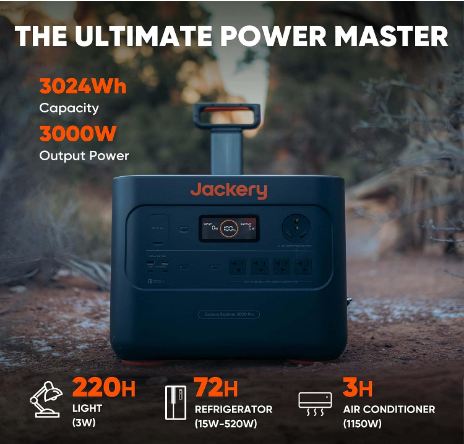
Typically, the first thing you want to know is whether a particular solar generator can run whatever you want to power.
The number and power consumption of your appliances or electronics determines how big (in terms of power output) of a solar generator you get.
If you have a few small camping appliances, a 500W solar generator would probably be enough. For larger appliances like a refrigerator, TV and space heater, a 1000W-2000W solar generator is more suitable.
If you have multiple household appliances you want to power, get a 3000W+ solar generator.
The best way to size a solar generator is to add up the wattage of all the appliances you plan to run at the same time. Then get a solar generator with power output slightly higher than that.
2. Capacity & Expandability
As with power output, the wattages of your appliances will tell you how much capacity you need. But this time, you’ll need to calculate the watt-hours (Wh). This is the amount of power all your appliances and electronics consume in an hour.
Use the Wh to determine how much capacity you need. For instance, a 100Wh TV will consume 500Wh daily if you watch it for five hours a day. So you’ll need a 600-700Wh solar generator to power the TV for a day (not all of a solar generator’s capacity is available for use — usually 80 to 85%).
The size (in terms of capacity) of the solar generator you get also depends on how long you want to power appliances. If you want backup power for two days, you’ll need a pretty big solar generator.
Generally, the same criteria that applies to power output also applies to capacity. In fact, you’ll find that the power output and capacity on most solar generators are roughly matched.
For small appliances and electronics a 200Wh-700Wh solar generator is ideal. It’s also light enough for camping and travel.
For larger appliances, get a 1000Wh-2000Wh solar generator. If you want a solar generator that can power most household appliances, make sure it has a capacity of at least 2000Wh (2kWh).
If you want to power multiple large appliances or part of your home for an extended period like a few days, get an expandable solar generator. This lets you add more batteries to increase the solar generator capacity. It will be expensive, though.
3. Portability
When deciding solar generator capacity, you have to balance between runtime (how long you can power your appliances & electronics) and weight (as well as price).
A higher capacity solar generator will power your stuff for longer, but it will be heavier and more expensive. That’s because the battery is the heaviest and most costly component in a solar generator.
So if portability is important for you, you may have to compromise on capacity.
If you are getting a camping solar generator, make sure it’s light enough to carry over short distances by hand (under 20lbs). For RVs, trucks and camper vans, you can afford to get a heavier, higher-capacity solar generator since you probably don't need to move it around often.
If you are getting a solar generator primarily for home backup, forget about portability and focus on capacity and power output. Once you’ve set it up, you won’t need to move it again. So weight is not as important.
4. Number & Type of Outlets
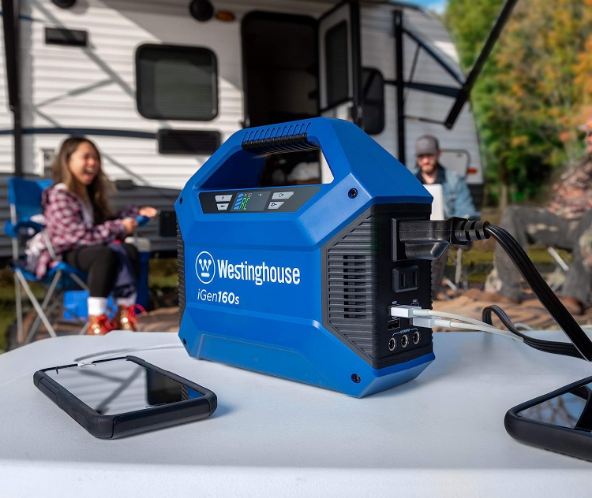
Any solar generator, even a small one, should have at least three types of outlets: AC, DC and USB. This ensures you can connect just about any kind of appliance, device or electronic to the solar generator.
For AC, we recommend 2-3 AC outlets for smaller solar generators and at least 4 for larger units. You should be able to plug in multiple appliances at the same time.
Larger (2kW+) solar generators should also have a 30 amp AC outlet for connecting to your RV or home circuit (handy for home backup or off-grid power).
For DC, a 12V car port is standard though some solar generators also have two 5.5mm DC outlets for smaller electronics and a 12V/30A RV outlet.
For devices, check that the solar generator has at least 4 USB ports. Most people/families have multiple devices like a camera, several smartphones, a tablet and so on. You should be able to charge several of them at the same time.
Look for fast charging (QC) USB-A ports as well as 60W-100W USB-C ports that can power larger gadgets like a laptop.
5. Recharging Options & Performance
One of the biggest improvements in modern solar generators is how fast they charge. Even solar charging, which used to take days in older models, is now really fast.
A decent solar generator should charge in 5 hours or less via a wall outlet or solar. Make sure there’s also a car charging option, though it’s usually slow. But it's handy if you spend a lot of time on the road.
The bigger the solar generator, the faster its charging speed should be. Some huge solar generators take just a couple of hours to recharge.
A bonus charging feature to look for is simultaneous dual charging from solar + AC or two wall outlets. This speeds up charging even further.
6. Type of Battery
Don’t even bother getting a lead-acid solar generator. Those are outdated and highly impractical.
Solar generators these days use lithium-ion batteries. There are two types: Li-ion NMC and LiFePO4 or lithium iron phosphate.
Li-ion NMC batteries are lighter and cheaper. So solar generators using these types of batteries have easier portability. They are great for camping and outdoors.
LiFePO4 batteries are heavier but they last much longer. The cycle life of a LiFePO4 battery is 2000-3000 cycles to 80% capacity (how many charge/discharge cycles it lasts before battery capacity deteriorates to 80%).
In contrast Li-ion NMC batteries have a cycle life of 800-1000 cycles.
Here’s our recommendation: if you plan to use the solar generator very often, a LiFePO4 solar generator will have a longer lifespan. But if you only plan to use the solar generator occasionally (e.g. camping a couple times a month and occasional home backup), then a Li-ion NMC solar generator will also last a long time.
For large solar generators such as those for RVs or home backup, LiFePO4 is always the best choice. The solar generator is already heavy, so a few extra pounds are worth the longer lifespan of a lithium phosphate battery.
7. Warranty
Finally, check the warranty of the solar generator to make sure you are getting a high quality product. Most solar generators from reputable brands have a minimum 2-year warranty.
Larger and more expensive solar generators have a 3-5 year warranty.

